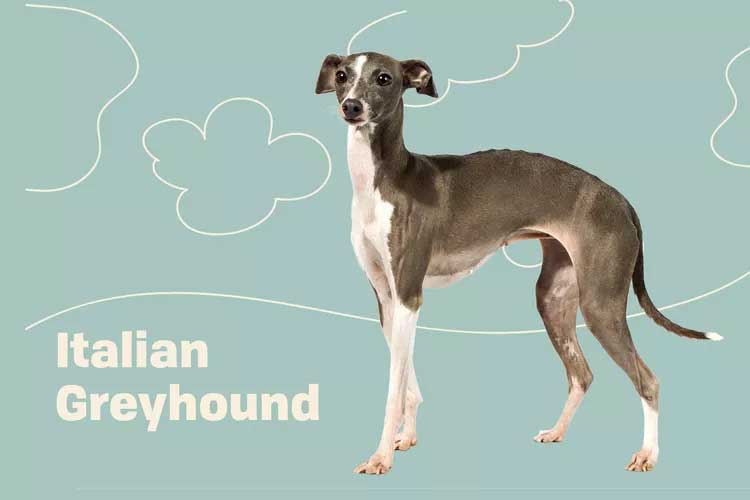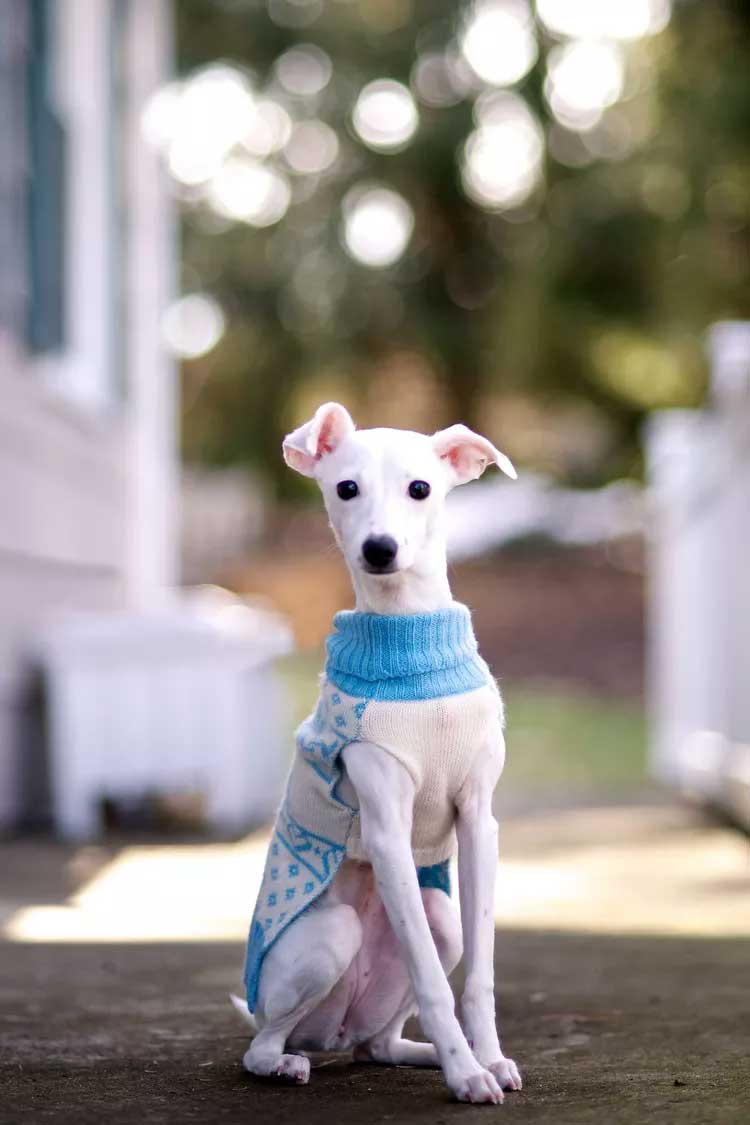Athletic. Regal. Suuuuuper tiny. Welcome to the wonderful world of the Italian greyhound.

Italian Greyhound Overview
| OFFICIAL NAME | Italian Greyhound |
| COMMON NAME | Italian Greyhound |
| PET HEIGHT | 13 to 15 inches |
| PET WEIGHT | 7 to 14 pounds |
| LIFESPAN | 14 to 15 years |
| GOOD WITH | children, dogs, families, seniors |
| TEMPERAMENT | friendly, outgoing, playful |
| INTELLIGENCE | medium |
| SHEDDING AMOUNT | infrequent |
| EXERCISE NEEDS | high |
| ENERGY LEVEL | hyper |
| VOCAL LEVEL | when necessary |
| DROOL AMOUNT | low |
| BREED GROUP | toy |
| BREED SIZE | small (0-25 lbs.) |
| COAT LENGTH | short |
| COLORS | black, blue, brown / chocolate / liver, fawn, gold / yellow, gray, red |
| PATTERNS | bicolor |
| OTHER TRAITS | apartment-friendly, easy to groom, easy to train, good for first-time pet owners, high prey drive, hot weather tolerant, hypoallergenic |
For centuries, the Italian greyhound has been the stuff of royalty. All throughout Europe and western Asia, these tiny sighthounds have been prized for their small stature, playful attitudes, and prowess as open field hunters.
The other thing kings and queens of old knew well: These little dogs make incredibly delightful family pets. Their loving nature and small size make them ideal lapdogs, as well as making them well-suited for apartment living and for families with smaller houses or yards.
Appearance
Prized for their small size, Italian greyhounds top out at a hair over 1 foot tall and weigh less than a typical bowling ball. Size aside, they look—as one might expect—exactly like greyhounds: Barrel chests down to slim, concave stomachs, and a slender, graceful neck tapering into an angular, aerodynamic head and snout. Much like their larger cousins, there is little mistaking the original purpose of these little dynamos: straight, uncut speed.
Their fur comes in a very short single coat that can be found in a multitude of colors: gray, yellow, red, fawn, black, or blue. Bicolors occur as well, usually a darker color with white, or as a fawn and blue or black and blue combination. Their eyes are large and alert, a testament to their "sighthound" classification. These little guys are always on the lookout for small game and ready to give chase at the slightest provocation.
Italian greyhounds are also commonly confused with another sighthound: the whippet. But, as members of the hound group, whippets are much larger (ranging 25–40 pounds) than this toy breed that tops out at 14 pounds.
Temperament
Italian greyhounds are bright little dogs, but they also come equipped with somewhat sensitive emotional dispositions, according to the Italian Greyhound Club of America (IGCA). As such, these dogs respond extremely well to positive reinforcement, and treats are always appreciated.Because of their emotional nature, these are not dogs who do very well when left alone for long periods of time. If they are the only animal in the house and you're going to be gone for more than a couple hours at a time, separation anxiety is a concern, which can result in panic barking, chewing, or nervous wetting. Luckily, Italian greyhounds do remarkably well with other dogs, so if there is a companion in the house, everything should be wine and roses. But for single-dog homes, a lot of it will come down to conditioning.

"Kennel training is so important, especially with puppies," says Michelle Beck, DVM, CCRT, CVA-Veterinarian, with the Backlund Animal Clinic in Omaha, Neb. "The kennel is not a place for punishment; it's for security. So working with them to see that kennel as a safe spot. Then building up that familiarity with the kennel so they don't get upset when you walk away."
Italian greyhounds are hunting dogs at their heart, and come blessed with incredibly high prey drives. If something their size or smaller makes any sudden moves, it will get chased. For this reason, cats as roommates are almost certainly going to be a non-starter for most Italian greyhounds, even with early socialization, as it's just going to be too easy for them to trigger that chase instinct.

Also, yards without a fence or walks without a leash are strongly advised against, because this pup is a dog who's going to take off after every squirrel it sees. And once she gets a head of steam up (which happens very quickly), you're not going to be able to catch up to her again until she stops.
Italian greyhounds are fairly easy to train and enjoy learning tricks or going on runs with you, but because of that high natural high prey drive, they make poor choices for agility or flyball competitions because of their high potential for distraction. However, lure competitions were literally made for sighthounds and, even better, require no training on your part. Just find a competition and let nature take its course.
"It's a great bonding activity, and it's mental stimulation for dogs," Beck says.
Living Needs
These dogs are so easy! Italian greyhounds are an excellent choice for the first-time or novice owner because they have so few demands that can't be met with a little spare time and some love. They're excellent for small children, and while they are capable of being athletic dogs, they are small enough to be able to get all their exercise needs met on the living room floor, which means that even seniors can keep them active relatively easily."What's interesting about the Italian greyhound is that we think of them as these athletes," Beck says. "But they're sprinters. So they're active for very short periods of time, but otherwise, they're lazy. So if you're looking for an active-all-the-time dog, that's probably not the right dog for you, because they're sprinters and not endurance runners."

Again, if you're going to have your Italian greyhound in the yard, a secure fence or leash is going to be imperative, because they will take off after anything that catches their eye.
Their small size and short single coat do mean that if you live in a colder climate, you're going to have to take some extra precautions with them in the wintertime. Say hello to Instagram-worthy tiny dog clothes and boots! They will, however, do well in warmer weather if you keep any outdoor exercise limited to the morning or evening (when the sun isn't quite as hot) to prevent heat exhaustion.
Care
Once again, this is an area where the Italian greyhound shines for new owners and people living in smaller spaces. The Italian greyhound is a wonderfully low-maintenance dog: Baths will really only have to happen if they get something on their fur you can't just brush out. Their short coats hang on to very little, which not only keeps them clean but also means they don't tend to develop any odors along the way.
Their nails will grow relatively quickly, so you'll probably have to cut or file them down once or twice a month, and you'll want to keep their teeth clean as well. The IGCA recommends daily teeth brushing.
Health
There's some good news here, too: Italian greyhounds are very long-lived little dogs, commonly living between 13–15 years. They also, according to a 2010 study by the Orthopedic Foundation for Animals, have the lowest incidence of hip dysplasia among the (then) 157 breeds recognized by the American Kennel Club.The breed can have issues with autoimmune problems, Legg-Calve-Perthes disease, and hypothyroidism. And, even though they are tough little dogs, broken legs can be a problem for the slender breed if they're allowed to jump from too high of a height, or if they trip on uneven terrain at full speed.
Additionally, the Italian greyhound can have a propensity for putting on weight, especially as she gets older, or if her activity needs aren't being met. Talk to your veterinarian about how you can keep your dog's weight under control with proper nutrition and exercise.
History
Italian greyhounds have been around for a while. Archeological work has found evidence of them having been bred during the Roman empire, 2,000 years ago, according to the Italian Greyhound Club. They remained a popular dog in Greece and Turkey for centuries but really gained European attention during the Renaissance.Throughout the 16th and 17th centuries, Italian greyhounds held sway in royal courts across Europe and western Asia, and were featured in a number of paintings by Renaissance masters.

The Kennel Club registered the Italian greyhound in 1875 and the AKC followed suit in 1886, making it one of the first breeds for both organizations. In the 20th century, the Italian greyhound suffered the effects of the World Wars as mightily as most every other dog of European origin. After both wars, it fell to American breeders to keep the breed alive and growing.
Fun Facts
Royalty loved the Italian greyhound. Frederick the Great, Louis XI of France, Charles VIII of France, and Queen Victoria all had the little dogs in their castles and homes.An African king named Lobengula once swapped 200 head of cattle for a single Italian greyhound.
The aesthetically pleasing little dogs were also favorites among painters, and the Italian greyhound has been featured in paintings by Giotto, Sassetta, Tiepolo, and Bosch.
Arguably the most famous Italian greyhounds alive today are Kermit and Peach, owned by long-time YouTube star Jenna Marbles. Prior to Marbles' August 2020 announcement that she was leaving YouTube, she and her pets racked up hundreds of millions of views appearing in dozens of videos such as "making my dog a bed out of soap."